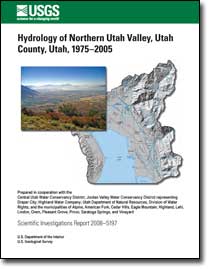 Abstract Abstract
The ground-water resources of northern Utah Valley, Utah, were assessed during 2003-05 to describe and quantify components of the hydrologic system, determine a hydrologic budget for the basin-fill aquifer, and evaluate changes to the system relative to previous studies. Northern Utah Valley is a horst and graben structure with ground water occurring in both the mountain-block uplands surrounding the valley and in the unconsolidated basin-fill sediments. The principal aquifer in northern Utah Valley occurs in the unconsolidated basin-fill deposits where a deeper unconfined aquifer occurs near the mountain front and laterally grades into multiple confined aquifers near the center of the valley.
Sources of water to the basin-fill aquifers occur predominantly as either infiltration of streamflow at or near the interface of the mountain front and valley or as subsurface inflow from the adjacent mountain blocks. Sources of water to the basin-fill aquifers were estimated to average 153,000 (+/- 31,500) acre-feet annually during 1975-2004 with subsurface inflow and infiltration of streamflow being the predominant sources. Discharge from the basin-fill aquifers occurs in the valley lowlands as flow to waterways, drains, ditches, springs, as diffuse seepage, and as discharge from flowing and pumping wells. Ground-water discharge from the basin-fill aquifers during 1975-2004 was estimated to average 166,700 (+/- 25,900) acre-feet/year where discharge to wells for consumptive use and discharge to waterways, drains, ditches, and springs were the principal sources.
Measured water levels in wells in northern Utah Valley declined an average of 22 feet from 1981 to 2004. Water-level declines are consistent with a severe regional drought beginning in 1999 and continuing through 2004. Water samples were collected from 36 wells and springs throughout the study area along expected flowpaths. Water samples collected from 34 wells were analyzed for dissolved major ions, nutrients, and stable isotopes of hydrogen and oxygen. Water samples from all 36 wells were analyzed for dissolved-gas concentration including noble gases and tritium/helium-3. Within the basin fill, dissolved-solids concentration generally increases with distance along flowpaths from recharge areas, and shallower flowpaths tend to have higher concentrations than deeper flowpaths. Nitrate concentrations generally are at or below natural background levels. Dissolved-gas recharge temperature data support the conceptual model of the basin-fill aquifers and highlight complexities of recharge patterns in different parts of the valley. Dissolved-gas data indicate that the highest elevation recharge sources for the basin-fill aquifer are subsurface inflow derived from recharge in the adjacent mountain block between the mouths of American Fork and Provo Canyons. Apparent ground-water ages in the basin-fill aquifer, as calculated using tritium/helium-3 data, range from 2 to more than 50 years. The youngest waters in the valley occur near the mountain fronts with apparent ages generally increasing near the valley lowlands and discharge area around Utah Lake.
Flowpaths are controlled by aquifer properties and the location of the predominant recharge sources, including subsurface inflow and recharge along the mountain front. Subsurface inflow is distributed over a larger area across the interface of the subsurface mountain block and basin-fill deposits. Subsurface inflow occurs at a depth deeper than that at which mountain-front recharge occurs. Recharge along the mountain front is often localized and focused over areas where streams and creeks enter the valley, and recharge is enhanced by the associated irrigation canals.
|
Part or all of this report is presented in Portable Document Format (PDF); the latest version of Adobe Reader or similar software is required to view it. Download the latest version of Adobe Reader, free of charge. |